You may have seen this photo online recently of EDF’s floating offshore vertical-axis wind turbine (VAWT) called “Vertiwind.” It has a nameplate capacity of two megawatts. The Vertiwind will be part of EDF-EN’s offshore wind farm project called Inflow, which the European Commission is helping fund.
The strange design piqued my curiosity about VAWTs. Why would a developer opt for a VAWT over a horizontal-axis wind turbine (HAWT)? And, are there good reasons for more developers to consider VAWT models?
Let’s look at how a VAWT works and how it stacks up against the horizontal-axis wind turbine. There are three basic advantages of a VAWT over HAWT and just as many drawbacks. For instance:
Fewer components – Obviously, the main rotor shaft of a VAWT is oriented vertically rather than horizontally. The advantage here comes as a reduction in parts. A conventional HAWT must first be generally oriented into the wind before the blades can rotate. In contrast, the blades of a VAWT catch wind in any direction without directional orientation. This makes it ideal for gusty conditions. What’s more, there is no need for components to control yaw and pitch.
Safety – Keeping workers from climbing tall turbine towers also makes VAWTs a safer alternative. Maintenance costs are further reduced because gearboxes, generators, and most electrical and mechanical components are at or near ground level, avoiding the need for climbing gear, lifts, and danger-pay compensation.
Scaling down – the design has potential to scale down and remain fairly efficient in dense urban areas or on rooftops where other renewable technologies might not be feasible. The residential possibilities of the VAWT model seem promising in reducing energy consumption from hydrocarbon sources.
Despite the plusses, there are good reasons that many are skeptical of VAWTs’ potential to ever be adopted on a wind farm. For instance:
Efficiency – When the wind blows on the blades of a HAWT, all of them contribute to energy production. When wind blows on a vertical-axis turbine, only a fraction of the blades generate torque while the other parts merely ‘go along for the ride’. The result is comparably reduced efficiency in power generation.
Simply put, because power generation efficiency isn’t as good, VAWTs aren’t as good long-term investments. This is ultimately why wind-energy developers have stuck with the HAWT. An owner’s greatest concern is simply generating as much power as possible over 20 plus years. Until recently, no prototype VAWT was close to the long-term generating capacity of horizontal-axis designs. Conventional VAWTs have no such optimization control, not yet, at least.
Scaling up – There are a number of obstacles in scaling VAWTs to commercial size. The first is that they aren’t as sturdy, by design, as a HAWT. This is because of where a HAWT carries most of its stress compared to widely-used VAWT models.
A large VAWT must be secured with many long guy-wires, especially those of the so-called “egg beater” design (link here). Conventional wisdom says that a VAWT wind farm of commercial scale would require more materials and space to generate a comparable amount of power as a farm equipped with horizontal-axis turbines. It’s not that VAWTs can’t be scaled to commercial purposes, they can, but the number of distinct challenges in doing so come without advantages in terms of cost or efficiency.
More maintenance – While a VAWT has fewer components that can wear and require repair, the forces acting on the machine are more turbulent than those on a HAWT. When a HAWT is pointed in the right direction, the blades are also pitched optimally. This is why pitch and yaw controls are worth their maintenance costs they incur compared to not having these controls at all.
In addition, smaller VAWTs that one might find on top of a city structure such as a stadium or apartment building, experience what some call jostling forces. These generate lateral stress that can only be accounted for with more and sturdier materials, and by ensuring regular maintenance.
VAWTS are still a popular design among enthusiasts and amateur engineers because they pose a number of fascinating challenges and have potential uses when the challenges are met. They remain popular for small-scale and residential installations where tight spaces limit the kind of renewables that can be installed. However, this might change in the near future with the recently announced Archimedes design (link), which is closer to a HAWT. What’s more, due to its small size, it shares some of the benefits of both the HAWT and VAWT models.
What about offshore VAWTs? One argument to discourage development of offshore VAWTs is the (assumed) limitations to size and the proven and significant generating capacity of offshore HAWTs. It is generally held that there must be a limit to how big developers can go with a conventional HAWT design and OEMs may be approaching the limit. So why not VAWTs?
It’s difficult to argue that the potential benefits of a VAWT design are worth the development resources. In the current market, investors and developers have reason to be skeptical of offshore VAWTs. But give credit to EDF-EN for attempting to do things differently and for not shying away from the engineering challenges mentioned here. Still, I am as yet unconvinced of the necessity of such a project let alone its cost-effectiveness compared to the established horizontal-axis design.
— Andrew Merecicky
Filed Under: Turbines

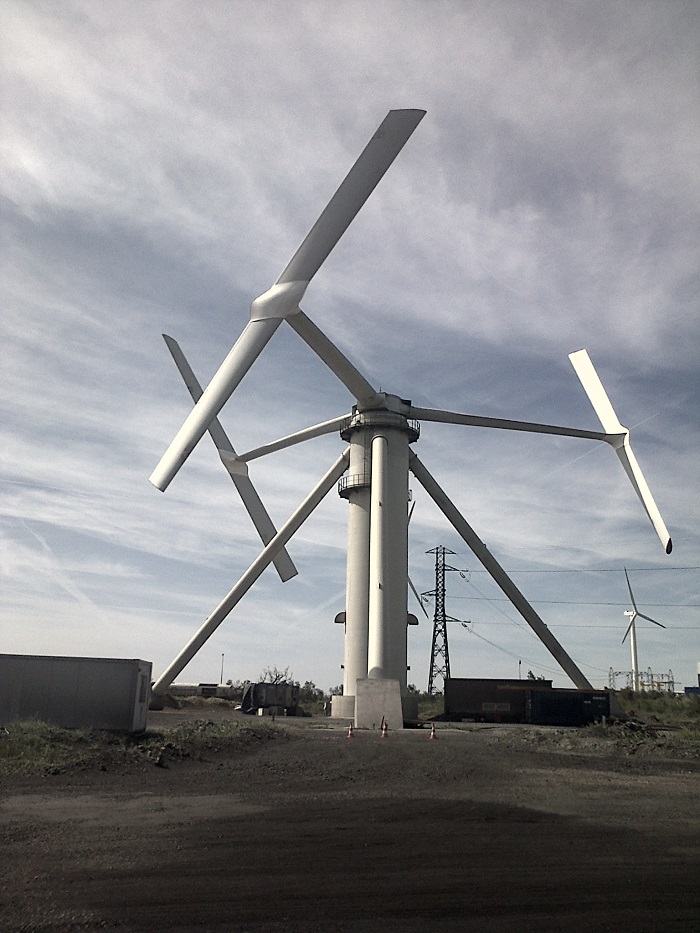
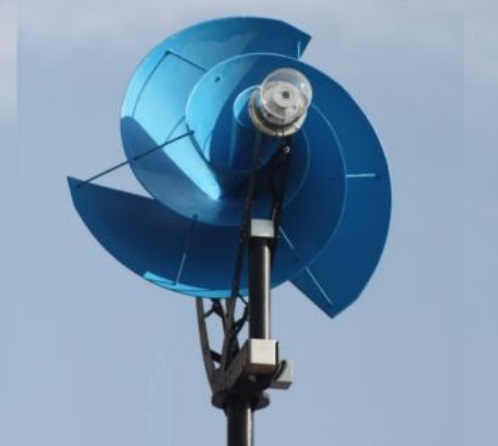
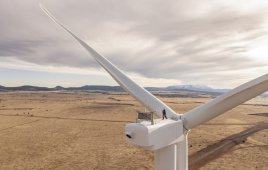
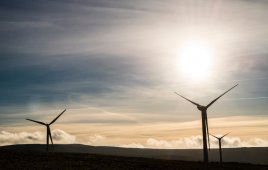
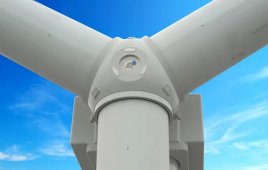
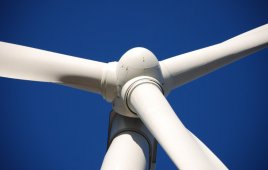
Well done, thank you!
To get anywhere near the potential capacity of a VAWT extreme diameters are required. This requires a different support mechanism and going away from radial arms. Buy floating a circular structure and linking it to a central hub via spokes or cables there need be no limit to the diameter, The whole structure including the liquid ( water ) on which it floats become a giant flywheel. At large diameters a TSR of around 3 results in a massive amount of stored kinetic energy without high G forces. Taking the concept to extreme with 300 m aerofoils set 40 m above the water on a PCD of 2500 m results in a potential of 375 MW in winds of 3 m/s. There is more information on the concept in maxwindpower.com
you all should read the website of ANew Institute, a Krakov, Poland group of aerodynamic engineers, and engineers.(
Note no space between the A and the N.
Each blade captures the wind twice in each rotation; the second time the same wind strikes the backside. The aerofoils are symmetrical.
the wind speed is diminished when it strikes the backside; so the combined efficiency can be as high as .45+ .20,=.65
All critics should study this excellent web site and understand it before sounding off against the VAWT.
I want to present their version of the wind turbine rotor sailing.It does not require a mechanism to limit turnovers. Quick replacement. Low cost. Resistant to icing. It is easy to scale.
https://drive.google.com/open?id=0B0QwbEzc33b9MDlpOHg0NlduTkU&authuser=0
http://uapatents.com/5-77932-vitrove-koleso-vitroenergetichno-ustanovki-z-vertikalnoyu-vissyu-obertannya-rotora.html
http://uapatents.com/6-77931-shhogla.html
http://uapatents.com/6-78408-vitrove-koleso-vitroenergetichno-ustanovki-z-gorizontalnoyu-vissyu-obertannya-rotora.html
http://uapatents.com/6-78806-vitrove-koleso-vitroenergetichno-ustanovki-z-vertikalnoyu-vissyu-obertannya-rotora.html
http://uapatents.com/9-88805-energetichna-ustanovka-sbp-2.html
A NEW DEVELOPMENT ON VERTICAL-AXIS WIND TURBINES: THE DIRECTIONAL WIND FLOW AND PROTECTIVE SCREENS.
In recent years wind turbines have become an increasingly important source of renewable energy and are being used by many countries as part of a strategy to reduce reliance on fossil fuels.
While most wind turbines are configured for rotating about a horizontal axis, a relatively newer type of wind turbine- known as a vertical-axis wind turbine (“VAWT”) – is configured for rotating about a vertical axis. One advantage of this arrangement is that the wind turbine does not need to be pointed into the wind to be effective, which is an advantage on a site where the wind direction is highly variable. It is also an advantage when the wind turbine is integrated into a building because it is inherently less steerable. Also the generator and gearbox are able to be placed near the ground, using a direct drive from the rotor assembly to the ground-based gearbox, which improves accessibility for maintenance purposes.
The speed at which a wind turbine – both horizontal-axis and vertical-axis – rotates must be controlled for efficient power generation and to keep the turbine components within design speed and torque limits.
All wind turbines are designed for a maximum wind speed – often referred to as the “survival speed” – above which they will suffer mechanical damage. With respect to VAWT´s electrical or mechanical brakes are often employed and used for slowing down the blades rotation as needed to prevent the turbine from exceeding its survival speed. However, such braking means require a potentially significant expenditure of energy when utilized. Additionally, depending on the speeds, the heat generated by such braking has the potential to create a fire inside the nacelle if used to stop the turbine from full speed.
Therefore, there remain a need for minimizing the energy required to brake and protect a vertical-axis wind turbine during survival speeds winds. Aspects of the present invention fulfill these needs and provide further related advantages as described as follows.
The present invention-innovation solves the problems described above by providing a vertical-axis wind turbine apparatus having two deployable screens.
One deployable screen function is with the help of a weather-vane on the housing top of the apparatus and configured for causing the blades housing to selectively rotate about the main shaft and orient the catch portion of the blade assembly circumference ( exterior screen )into the wind, to allow only for the turbine to catch the wind on the rotating direction of the turbine by exposing to the wind the positive side of the blades and making part of this wind to circulated whiting the housing working on the back of the blades inside the housing , therefore increasing the efficiency of the turbine and making it possible to rotate with less wind speed. This housing is configured for shielding the return part of the blade assembly circumference from the wind.
A second screen is rotatably engaged with the housing and configured for selectively moving between a retracted position, wherein the second screen is positioned substantially adjacent to the first screen such that the catch portion of the blades assembly circumference is exposed, and a deployed position, wherein the second screen is rotated away from the first screen for partially or totally shielding the catch portion from the wind. Thus during use of the apparatus, the second screen is capable of selectively moving into the deployed position upon the occurrence of environmental conditions that would otherwise potentially damage the blade assembly
This second screen will operated as the wind speed reaches near the “survival speed”, closing down partially or totally the portion of the blade assembly exposed to the wind, by means of a separated electric motor controlled electronically by a tachometer configured for determining the rotational speed of the blade assembly. This way allowing only the amount of wind needed for the speed rotation of the turbine to produce energy. Therein, the need for a slowing down system is unnecessary, consequently minimizing the wear of the apparatus and extending the periods of services needed.
Another advantage future on this two screen system is that if the wind turbine is used on a storing energy system, once the batteries are charge full and there is not storing capacity left, the motor of the second screen will be activated – as in the situation of too severe weather conditions- deploying the second screen shielding the blade assembly from the wind slowing the rotation gradually to a standstill, thus adding a durability to the apparatus by reducing the wear of the mechanical parts.
Lately a company named Teslas had developed a battery “The Powerwall “ for home storing systems that is a revolutionary technology. Cost for a 7 kWh is $3000 and $3500 for the 10 kWh. http://www.teslamotors.com/powerwall
We believe for what we understand reading their technical data that only a short period of time will be needed for our turbine to charge the Powerwall battery as well as reducing the size of the apparatus making it very suitable to be located on city buildings. Must add that our turbine is noiseless and vibration free.
The ecologist movements around the world are very concerned about the amount of birds killed by the horizontal-axis wind turbines. On our case that hazard is reduced to cero.
Another idea is that the housing screen can be used for displaying a logo or commercial advertisement if the location is suitable for such purpose.
At the moment we have new ideas to add to this inventions but unfortunately the shortage of funds to invest is a mayor handicap and we are looking for possible investors on the project.
Any ideas on how or where to find funds are welcome!!!!!!!!!!!!!!!
Contact Aurelio Izquierdo: aurelioi25@hotmail.com Spain 727727172
Or lorentalavan@gmail.com Spain 639172005
I’ve a question!
How can you argue about history of vertical and horizontal axis wind powers? Any question to follow the “red line”?
It’s Urgent!
When I was a Senior Mechanical Engineering student at the University of Pittsburgh, in 1975, our senior design project was to develop a vertical shaft windmill. It was very difficult to generate enough power, even with higher wind velocities (we simulated with high pressure air in a venturi. We needed to shield half of the windmill, else the wind counteracted when the vane rotated back. It was interesting but frustrating. I never entered into this field but I did end up working for a large compressor and turbine manufacturer for 17 years.
It all comes down to the long term wind regimes, sea state conditions, water depths and saline impacts of the off shore wind farm. As long as the wind machine is rigidly mounted on the bottom (shallow water), HAWT’s will carry the day. HAWT’s mounted on off-shore jacket structures must sustain a geometrically more severe cost increase with water depth than do petroleum production platforms for the same rate of depth increase because of the confounding need for taller and bigger machines to justify the water depth cost growth. For sites subject to seasonal gales and worse, the cost factor is further magnified disproportionately for all types of machines rigidly attached to the bottom.
A concept yet to be investigated for floating deployment is a down-wind HAWT on which the turbo-machinery rotational works are mounted on a bi-axial gimbals that is constantly adjusted by servo hydraulics for pitch and yaw, thereby allowing a few degrees of yaw and a few more degrees of pitch adjustment in real time for variable vectored wind forces causing quasi-cone (convoluted) surface tracing of the out of vertical positioning of a mast mounted on a tethered float system containing the servo hydraulics. The parasitic energy losses are an issue, but should be proportional to the available wind energy.
This is a good article on the pro’s & con’s of HAWT and VAWT wind turbines. I have a fundamentally different VAWT design, based on the involute spiral, that solves most of the disadvantages of the VAWT. (see http://fundamentalform.com/html/involute_wind_turbine.html) The non-constricting spiral curvature of 3 or more vanes channels the wind into the center, like a venturi, where it spirals into the open center, then out the low-pressure channel, thus rotating the turbine through both lift and drag throughout its depth. This captures much more power from the wind than a propeller-blade HAWT, since the wind is not propelled outward, which loses power and creates turbulence, but rather channeled inward in a 3-dimensional configuration, rather than the flat plane of a HAWT (responsible for the maximum efficiency calculated by Betz of 59% ). Additionally, the laminar, spiral inward flow of air creates little turbulence while entraining the surrounding air by the low-pressure downstream created by the power extraction. This further enlarges the effective volume of wind contributing to the turbine power. Many more advantages are enumerated on my webpage, including the ideal engineering offered by this design, which allows a 4ft diameter turbine on a 20ft revolving mast to weigh less than 30lb, including turbine, mast bearings, and guy cables. The revolving mast puts the heavy generator at ground-level. This VAWT design would be ideal for the wind-farm clockwise-counterclockwise array of VAWTs mentioned by Tom DiCorcia above. This VAWT design is crying for further R&D work to determine its efficiencies.
This article is not up to date with the latest developments in VAWT turbines. VAWT’s inherent design superiority has now been fully realized if you do a web search on ArborWind. ArborWind’s turbine doesn’t require guy wires, is more efficient than the HAWTs, is also more durable with 50 year design life and doesn’t require significant maintenance. Recently completed full scale testing has validated the design which is now commercially available in the 60 kW size and is undergoing certification.
This article is not up to date with the latest design in VAWT turbines. VAWT’s inherent design superiority has now been fully realized. See ArborWind’s patented design (www.arborwind.com) which doesn’t require guy wires, is very efficient and durable (50 year design life), etc. Recently completed full scale testing has validated the design which is now commercially available in 60 kW capacity.
Note U.S. Patent number 4134708 of 1979 regarding vertical wind power generation. Also variation on claim number 9.
BB
Paul’s comments are on the mark. The fact is, only high tower systems encounter strong enough, steady enough winds to guarantee the power (which scales like velocity cubed) is optimized. This criteria eliminates almost all VAWTs from consideration- they simply require too much superstructure and highly complex mechanisms to be practical. Except as greenwashing or for very specific niche applications.
However, it is possible to blend the simplicity of a two or three blade HAWT with some of the advantages of a VAWT– see spinorwind.com for details. The blades follow a a figure eight motion, rather than simply spin in a circle. Which drops the power efficiency. But, the figure eight captures energy from all directions, while maintaining the simplicity of long thin blades and a central gearbox. Increasing availability in non-optimal sites.
You should also consider system-wide effects. Research at Stanford and Cal Tech have postulated that arrays of VAWTs could output more power than arrays of HAWTs. HAWTs interfere with each other in a way that limits how closely you can place them in a wind farm. VAWTs can be packed more densely and may even be able to be positioned in a way that multiplies output.
Sorry
In addition, investment in wind energy, in particular onshore small wind, will suffer from increasing O&M costs.
VAWT’s offer massively reduced O&M costs, this make the investment more secure.
True cost of ownership of HAWT’s will drive the development of VAWT’s
Andrew
Good article, however your deduction of efficiency is incorrect.
Any efficiency losses in regards to all blades not producing lift is taken account of during the design phase.
A VAWT does not need to track wind and takes the wind from any direction, we take advantage of gusts and turbulence, HAWT’s do not like gusts or turbulence, in fact as gusts generally come from a different direction to the prevailing wind, gusts mean fatigue in HAWT,s.
Youtube 4N-55 VAWT
Your statement about efficiency is not right. The small VAWT my own company developed showed 0.43 peak aerodynamic efficiency in a wind tunnel – compared to HAWTs typical 0.5 and the theoretical maximum possible, 0.59 (Betz limit). – And this was for a small (6kW peak) turbine – so given aerodynamic scale effects one might expect similar efficiencies for VAWTs to HAWTs at large scale.
There are a number of projects underway to commercialise large VAWTs for offshore use, and there is good reason to suspect that they have advantages. For example, researchers at Sandia National Laboratories wind-energy stated: “The economics of offshore windpower are different from land-based turbines, due to installation and operational challenges. VAWTs offer three big advantages that could reduce the cost of wind energy: a lower turbine center of gravity; reduced machine complexity; and better scalability to very large sizes. A lower center of gravity means improved stability afloat and lower gravitational fatigue loads. Additionally, the drivetrain on a VAWT is at or near the surface, potentially making maintenance easier and less time-consuming. Fewer parts, lower fatigue loads and simpler maintenance all lead to reduced maintenance costs.”
(reference: http://www.renewableenergyworld.com/rea/news/article/2012/08/offshore-use-of-vertical-axis-wind-turbines-gets-closer-look).